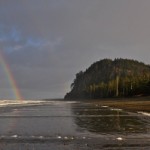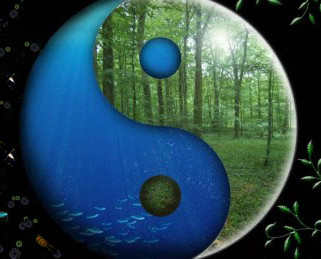
More Grass Growing Means Less Dust Blowing
More grass growing due to high and rising CO2 is good news for the Earth very bad news for the Oceans, that mere 72% blue part of our Blue Planet
An multi-national team has just published a study titled “Greening of the Earth and its Drivers“ in the journal Nature Climate Change showing significant global greening of Earth’s vegetated lands using data from NASA satellites over the past 33 years.
This post is not an all bad news report, read through to the ending where the hope and promise of the proven, safe, sustainable, and most of all low-cost solution we can immediately deploy to save our ocean pastures is presented.
The global greening detailed in this report represents an increase in leaves on grasses, forbs and trees. Since ours is a planet mostly covered in grass this is of course the same as saying the Earth’s ‘ground cover’ is increasing. That ‘ground cover context’ is where one has to take a moment to consider the most basic biology of this BLUE planet, and the role of mineral dust that blows in the wind. Since 72% of this planet has no ‘ground’ that vast area being all ocean is where the most pressing and present CO2 crisis has arisen and is seen in dramatic declines of dust-fall.
“The greening over the past 33 years reported in this study is equivalent to adding a green continent about two-times the size of mainland USA (18 million km2), and has the ability to fundamentally change the cycling of water and carbon in the climate system,” says lead author Dr. Zaichun Zhu, a researcher from Peking University, China, who did the first-half of this study as a Visiting Scholar in the Department of Earth and Environment at Boston University, USA, together with Prof. Myneni.
“We were able to tie the greening largely to the fertilizing effect of rising atmospheric CO2 concentration by tasking several computer models to mimic plant growth observed in the satellite data,” says co-author Prof. Ranga Myneni of the Department of Earth and Environment at Boston University, USA.
“Burning oil, gas, coal and wood for energy releases CO2 in to the air. The amount of CO2 in the air has been increasing since the industrial age and currently stands at a level not seen in at least half-a-million years. It is the chief culprit of climate change.”
Most important however is the fact that nearly a trillion tonnes of CO2 has already been emitted into the planetary atmosphere during our fossil fuel age. Given that CO2 has a lifetime in the air of about 200 years before it reaches equilibrium, primarily by dissolving into the oceans the crisis of CO2 driven global greening has only just begun. It will not be resolved by merely reducing tomorrow’s CO2 emissions as yesterday’s CO2 emissions will continue to impact this blue planet’s largest environment for centuries to come.
Last month in the same Journal Nature a report on the catastrophic decline of dust in the wind was presented in a paper titled: The Past, Present, and Future of African Dust
Green or Blue-Green Understanding Our Planets Plant Life
Our world sustains plant life in two forms, those green plants that live in soil and depend on vital rain/water that arrives in the wind to survive and thrive, such plants cover the 17% of this Blue planet that is not ice or rock and supports growing vegetation.
The rest, the 72% blue part, of this planet is filled with green plants, phyto-plankton, that lives in water and depends utterly on receiving vital mineral micronutrients that blow to it from the land in the form of dust in the wind. This is where the crisis of CO2 becomes most dire, as more grass growing means less dust blowing!
We are the problem, we must be the solution
The reduction of dust in the wind due to our high and rising CO2 has already resulted in a massive many decades long ‘drought’ of dustfall in the world’s vital ocean pastures. As a result ocean pasture productivity has collapsed around the world. While it is fashionably politically correct to blame the disappearance of fish in the oceans on convenient ‘bad over-fishing fishermen’ in reality it is each and everyone of us and our fossil CO2 emissions that is killing ocean life. This is not to say we are proposing to let the dastardly over-fishing bogey men off the hook as they are indeed compounding the crisis by over-fishing the last of dwindling fish populations dying out on rapidly disappearing ocean pastures. The good news is that we can immediately restore our oceans and their ocean pastures.

Worldwide collapse of sardines and anchovies is reported as their plankton food disappears, say German media – click to read more
Everyone knows the basics of pasture ecology, as the grass disappears from pastures, be they on land or at sea, those pastures lose the ability to sustain animal life.
It is easy to see the collapse of a pasture on land when grass growing disappears and the dusty dirt is all that remains with little or no grass to sustain our herds of domestic animals or wildlife.
Seeing ocean pasture collapse is more difficult as we humans only ever see the blue surface of our oceans, in fact most humans think the clearer and bluer the ocean is the more beautiful it is. Just look at any advertisement for a beautiful ocean holiday location.
Increasingly common reports of dying marine life reveal the crisis
Excerpt from the Nature Paper
The Authors of this new report in Nature note that every year, about one-half of the 10 billion tons of carbon emitted in to the atmosphere from human activities remains temporarily stored in the oceans and plants on land.
“While our study did not address the connection between greening and carbon storage in plants, other studies have reported an increasing carbon sink on land since the 1980s, which is entirely consistent with the idea of a greening Earth,” says coauthor Prof. Shilong Piao of the Chinese Academy of Sciences.
The beneficial aspect of CO2 fertilization in promoting plant growth has been used by contrarians, notably Lord Ridley (hereditary peer in the UK House of Lords) and Mr. Rupert Murdoch (owner of several news outlets), to argue against cuts in carbon emissions to mitigate climate change, similar to those agreed at the 21st Conference of Parties (COP) meeting in Paris last year under the UN Framework on Climate Change (UNFCCC).
“The fallacy of the contrarian argument is two-fold. First, the many negative aspects of climate change, namely global warming, rising sea levels, melting glaciers and sea ice, more severe tropical storms, etc. are not acknowledged. Second, studies have shown that plants acclimatize, or adjust, to rising CO2 concentration and the fertilization effect diminishes over time,” says co-author Dr. Philippe Ciais, Associate Director of the Laboratory of Climate and Environmental Sciences, Gif-suvYvette, France and Contributing Lead Author of the Carbon Chapter for the IPCC Assessment Report 5.
The Solution Ignored By The Journal Nature
The 32 authors from academic institutions in 8 countries completely neglect to offer the simple solution to the calamity of ocean pasture collapse brought on by global greening and dust decline. Sigh. Here’s my proven, simple, sustainable, safe, affordable, and immediately deployable solution that the human race must move forward with to save our oceans (and ourselves) from the global greening and grass growing ravaging of this blue planet. IT JUST WORKS!
We must replenish the dust our modern age has and is denying the oceans and their vital pastures. By giving back tiny amounts of mineral rich dust to the oceans we can bring back all of ocean life, the plankton, the krill, the squid, the seabirds, the seals and sea lions, the great whales, and the fish!
The cost of restoring our ocean pastures to historic levels of health and abundance will be absolutely trivial when compared to the expected trillions to be spent annually to full-fill the terms of the recent Paris Climate Change Accord. My proven methodology and technology can, and will, safely and sustainably restore ocean pastures in all of the world’s seven seas for mere millions of dollars, NOT trillions!















Iron fortification of ocean pastures may well be the greatest survival tool we shall ever receive. Please support Russ George in his effort to revitalize the oceans and help save our planet.